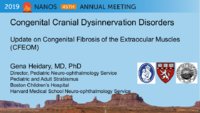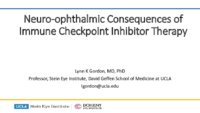The NANOS Annual Meeting Neuro-Ophthalmology Collection: Presentations from the annual meeting of the North American Neuro-Ophthalmology Society (NANOS), a professional organization of more than 600 members who are fully trained ophthalmologists or neurologists. Contains records from the first meeting in 1975 to the present.
NOVEL: https://novel.utah.edu/
TO
Filters: Collection: "ehsl_novel_nam"
| Title | Description | Subject | Collection | ||
|---|---|---|---|---|---|
| 176 |
 |
Proportion of Neuro-Ophthalmologic Disorders in Patients Referred to Neuro-Opthalmology for Visual Disturbances After Cateract Surgery | Underlying ocular, systemic or neuro-ophthalmologic conditions may result in postoperative visual disturbances in patients after uneventful cataract surgery. We sought to identify the proportion of patients who had a confirmed underlying neuro-ophthalmic disorder that were referred for neuro-ophthal... | Optic Neuropathy, Ocular Motility, Adult Strabismus with a Focus on Diplopia | Neuro-ophthalmology Virtual Education Library: NOVEL http://NOVEL.utah.edu |
| 177 |
 |
Adult with Acquired Oblique Diplopia: Do I Image? Do I Operate? (Slides) | Thyroid eye disease (TED) is an autoimmune condition typically characterized by an initial acute inflammatory phase, followed by a fibrotic phase that may affect orbital tissues and extraocular muscles. It is usually associated with hyperthyroidism(85%), but may occur in euthyroid (5%) or hypothyroi... | Oblique diplopia; Thyroid eye disease; Hypertropia; Restrictive strabismus; Superior oblique palsy | Neuro-ophthalmology Virtual Education Library: NOVEL http://NOVEL.utah.edu |
| 178 |
 |
Neuro-ophthalmic Complications in Patients Treated with CTLA-4 and PD-1/PD-L1 Checkpoint Blockade Inhibition (PDF) | In recent years, the use of CTLA-4 and PD-1/PD-L1 checkpoint blockade inhibitors have proven to be effective and become increasingly widespread treatment options for metastatic melanoma and other cancers by enhancing autologous anti-tumor immune responses. Immune related ophthalmologic complications... | Optic Neuritis, Myasthenia, Ocular Motility, Orbit, Chemotherapy and Radiation Injury | Neuro-ophthalmology Virtual Education Library: NOVEL http://NOVEL.utah.edu |
| 179 |
 |
Preparing for the Worst: Botulism - National Surveillance, Emergency Response, and Bioterrorism Preparedness | There are five major types of botulism: •Foodborne botulism from foods, most commonly homemade, that have been contaminated with botulinum toxin. •Wound botulism from spores entering wounds and making toxin. •Infant botulism when spores get into an infant's intestines, grow, and produce toxin.... | Botulism; Infectious diseases; Surveillance; Emergency; Bioterrorism | Neuro-ophthalmology Virtual Education Library: NOVEL http://NOVEL.utah.edu |
| 180 |
 |
Is It Time for Stem Cell Treatment? (Slides) | Stem cell transplantation is being explored as a treatment for vision loss associated with both ocular and neurologic diseases. This need arises because of the limited capacity for endogenous repair after injury in the mammalian central nervous system. Vision loss in optic neuropathies is associated... | Stem cell transplantation; Neuroprotection; Remyelination; Human embryonic stem cells (hESC); Induced pluripotent stem cells (iPSC) | Neuro-ophthalmology Virtual Education Library: NOVEL http://NOVEL.utah.edu |
| 181 |
 |
20190321_nanos_currentconcepts1_04_slides | |||
| 182 |
 |
Adult with Acquired Diplopia at Distance: Do I Image? Do I Operate? (PDF) | Adult onset divergence insufficiency (DIET) is a well-recognized condition that appears to be more prevalent now that the population is aging and staying more active. DIET is a more recent descriptive term of the clinical findings, but has also been referred to as "Divergence weakness in adults", "A... | Divergence Insufficiency; Esotropia; Strabismus; Diplopia | Neuro-ophthalmology Virtual Education Library: NOVEL http://NOVEL.utah.edu |
| 183 |
 |
Congenital Cranial Dysinnervation Disorders (Slides) | Patients with congenital cranial dysinnervation disorders (CCDD) may present with complex strabismus secondary to dysinnervation of the extraocular muscles. (1-3) Among the CCDDs, congenital fibrosis of the extraocular muscles (CFEOM) is a group of strabismus disorders characterized by blepharoptosi... | Congenital Cranial Dysinnervation Disorders; Congenital Fibrosis of the Extraocular Muscles; Complex Strabismus | Neuro-ophthalmology Virtual Education Library: NOVEL http://NOVEL.utah.edu |
| 184 |
 |
Preparing for the Worst: Botulism - National Surveillance, Emergency Response, and Bioterrorism Preparedness | There are five major types of botulism: •Foodborne botulism from foods, most commonly homemade, that have been contaminated with botulinum toxin. •Wound botulism from spores entering wounds and making toxin. •Infant botulism when spores get into an infant's intestines, grow, and produce toxin.... | Botulism; Infectious diseases; Surveillance; Emergency; Bioterrorism | Neuro-ophthalmology Virtual Education Library: NOVEL http://NOVEL.utah.edu |
| 185 |
 |
Neuro-Ophthalmic Consequences of Immune Therapy (Slides) | Although immune therapy is used in many types of diseases, from control of systemic inflammatory diseases, to treatment of multiple sclerosis and other demyelinating diseases, to advances in cancer therapy, this presentation concentrates on immune checkpoint inhibition, which is increasing used in c... | Cancer; Immunotherapy; Optic Neuropathy; Programmed Death 1 (PD-1); CTLA-4 | Neuro-ophthalmology Virtual Education Library: NOVEL http://NOVEL.utah.edu |
| 186 |
 |
Patient Harm from Diagnostic Error of Neuro-Ophthalmologic Conditions | Neuro-ophthalmic conditions are frequently misdiagnosed. We prospectively examined diagnostic error of neuro-ophthalmic conditions and resultant patient harm. | Diagnostic Tests (ERG, VER, OCT, HRT, mfERG, etc); Neuroimaging; Miscellaneous | Neuro-ophthalmology Virtual Education Library: NOVEL http://NOVEL.utah.edu |
| 187 |
 |
Non-specific orbital inflammation (NSOI) | Inflammatory optic neuropathy, or optic neuritis (ON), is the most common cause of optic nerve injury in young adults. Although high contrast visual recovery after idiopathic ON is generally considered to be good,1 poor visual outcomes are commonly observed in association with disorders such as neur... | Non-specific orbital inflammation (NSOI), Pseudotumor, posterior scleritis, orbital myositis, perioptic neuritis | Neuro-ophthalmology Virtual Education Library: NOVEL http://NOVEL.utah.edu |
| 188 |
 |
Superior Oblique Palsy and Its Mimics | This symposium is co-sponsored by the American Association for Pediatric Ophthalmology and Strabismus Adult Strabismus Committee. Diplopia and strabismus are commonly encountered in neuro-ophthalmic practice. Familiarity with management of strabismus resulting from neuro-ophthalmic pathologies is im... | Strabismus; Patient Counseling; Strabismus Surgery; Diplopia; Patient Evaluation | Neuro-Ophthalmology Virtual Education Library: NOVEL http://NOVEL.utah.edu |
| 189 |
 |
Practical Telemedicine: Tips for Video Visits | A fundamental skill developed in medical training is triage - the ability to determine which patients go to the ICU vs. floor, which patients come to the office vs. ED, and which patients follow up in 1 week vs. 6 months. For many seasoned providers, thes e decisions are reflexive as they have bec... | Video Visits; Synchronous Telehealth; Delivery of Care | Neuro-ophthalmology Virtual Education Library: NOVEL http://NOVEL.utah.edu |
| 190 |
 |
Neuro-Ophthalmic Side Effects of New Cancer Drugs (abstract) | War is a recurrent and unfortunate record in the history of human civilization that has culminated in indescribable violence and unspeakable death. However, amazingly within the confines of war have risen some of the greatest advancements in medicine (such as the intraocular lens by Sir Harold Ridle... | Cancer drugs, Immune checkpoint inhibitors, Molecularly targeted therapy, Toxicity, Immune-related adverse events | Neuro-ophthalmology Virtual Education Library: NOVEL http://NOVEL.utah.edu |
| 191 |
 |
Side Effects of New Immuno-Modulators (abstract) | Medications used in the management of rheumatologic disorders include therapeutic agents with varying mechanisms of action. The older well known drugs include glucocorticoids, non-steroidal anti-inflammatory drugs and the antimetabolites and cytotoxic medications such as cyclophosphamide, mycophenol... | Rheumatologic drugs, Biologics, Demyelination, Visual loss | Neuro-ophthalmology Virtual Education Library: NOVEL http://NOVEL.utah.edu |
